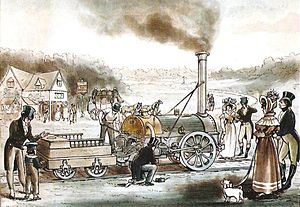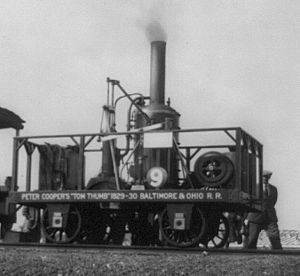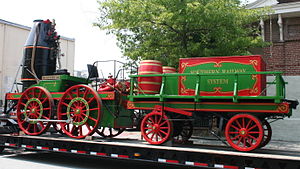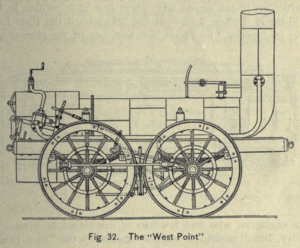User:Colin Douglas Howell/Galleries/Other Rocket-type locomotives and the first U.S.-built locomotives
After Rocket‘s success at the Rainhill Trials, Robert Stephenson followed it with several modified and improved versions, most of which served as the initial fleet of the Liverpool and Manchester Railway.
Meanwhile, the United States began its own first attempts in locomotive building around this time.
Stephenson's Invicta, 1829[edit]
Robert Stephenson built the locomotive Invicta for the Canterbury and Whitstable Railway immediately after finishing Rocket. Invicta was basically a four-coupled version of Rocket with front-mounted inclined cylinders. It was intended to work the lightest of the three major grades on the line, but this proved to be beyond its abilities; all three grades ended up being worked by stationary engines. In 1835 it was modified in an unsuccessful attempt to boost its performance, and it was retired in 1839. It was eventually preserved and restored, and it now resides in the Canterbury Heritage Museum.
-
Invicta on display at Canterbury in 1973. It has since been enclosed and restored, the red paint being removed.
Stephenson's Northumbrian-type 0-2-2 locomotives, 1830[edit]
During 1830 Robert Stephenson built eight further locomotives for the Liverpool and Manchester Railway with the same 0-2-2 wheel arrangement as Rocket but with several alterations, some of which were also performed on Rocket herself. First, the cylinders were enlarged, and their inclination was lowered to a nearly horizontal position, eliminating the rocking motion which Rocket had been afflicted with. The later engines were also equipped with a true smokebox integrated with the boiler shell. Finally, in the Northumbrian, the culmination of Stephenson's 0-2-2 development, the firebox was fully enclosed within the boiler with a surrounding water jacket, increasing the boiler's efficiency. Northumbrian was about two-thirds heavier than Rocket and a lot more powerful.
These 0-2-2 locomotives were the ones which officially opened the Liverpool and Manchester on September 15, 1830. However, they were quickly rendered obsolete by more advanced classes and were taken out of service within a few years. Except for Rocket, none of them were preserved, but the preserved Rocket is closer to their configuration than to her own original form for the Rainhill Trials.
-
An artist's depiction of Northumbrian.
-
A contemporary illustration of Northumbrian along with Liverpool and Manchester rolling stock.
-
View of a bridge on the Liverpool and Manchester, with a Northumbrian-type locomotive on the left.
Peter Cooper's "Tom Thumb", 1830[edit]
In 1830 Peter Cooper built the locomotive "Tom Thumb" to demonstrate the effectiveness of steam locomotives to the owners of the Baltimore and Ohio Railroad. It was the first American-built locomotive to run on a public railroad. (It actually never had a name; the nickname "Tom Thumb" was coined by an 1875 retrospective, and it stuck.) It had a vertical boiler using a belt-driven mechanical blower for draft, with a single vertical cylinder driving the front axle via gearing. No tender was used; coal was carried on board, while the boiler was refilled at intervals along the line. "Tom Thumb" was strictly an experimental machine, used for testing and demonstration runs until 1831; it never went into regular service. However, it did convince the B&O directors to purchase steam locomotives for the railroad, and their earliest machines were all vertical-boilered.
(Cooper did not continue as a locomotive maker; his goal was to stimulate B&O's growth, which would benefit his own local business interests. He went on to become a major American industrialist, philanthropist, and political activist, even running for President of the United States in 1876.)
"Tom Thumb" did not survive, but a replica was built in 1927 for the B&O's centennial and now resides at the B&O Railroad Museum. Most depictions of "Tom Thumb" are based on this replica, but it has major differences from the original.
-
The working replica of "Tom Thumb" built in 1927.
-
The "Tom Thumb" replica in action.
Best Friend of Charleston, 1830[edit]
Best Friend of Charleston, which entered service with the South Carolina Canal and Rail Road Company at the end of 1830, was the first American-built locomotive to run in regular service on a public railroad. It was an 0-4-0 tank engine with a vertical water-tube boiler at the rear and inclined cylinders at the front that drove a rear crank-axle. Best Friend of Charleston was used for regular passenger service around Charleston, but its career was very short; on June 17, 1831 its boiler exploded, killing the fireman and wounding the rest of the engine crew. The fireman had fastened the safety valve down to stop its hissing while the engineer was away from the engine. The remains of the locomotive were rebuilt with a conventional horizontal boiler and renamed Phoenix; in this form it ran until the Civil War.
A working replica, built in 1928, is currently on display at the Atlanta regional headquarters of Norfolk Southern Railway.
-
A somewhat inaccurate drawing of the Best Friend of Charleston.
-
Side elevation diagram of the Best Friend of Charleston.
-
The Best Friend of Charleston replica (with smokestack removed) being trucked to its new Atlanta home.
West Point, 1831[edit]
West Point, which was built in 1830 and began service with the South Carolina Canal and Rail Road Company at the start of 1831, was the second American-built locomotive to serve on a public railroad, immediately after Best Friend of Charleston. In fact, both locomotives had the same builder, the West Point Foundry, and West Point shared the same frame and running gear as its sister locomotive. Unlike Best Friend of Charleston, West Point had a conventional horizontal fire-tube boiler and carried a tender, and its cylinders were located at the rear, next to the firebox. In general layout, West Point resembled the Stephenson 0-2-2 locomotives, but its cylinders drove a front crank axle and all its wheels were coupled, making it an 0-4-0.
-
Side elevation diagram of the West Point (smokestack truncated).
-
Top plan view of the West Point.
-
A somewhat inaccurate drawing of the West Point. The coupling rods aren't shown, and no dome appears in the original plans.
De Witt Clinton, 1831[edit]
De Witt Clinton was built in 1831 for the Mohawk and Hudson Railroad. It was the fourth locomotive built in the U.S. and the first to run in the state of New York. Built in part by the West Point Foundry, it had a similar layout to their previous locomotive West Point. Like West Point, De Witt Clinton was an 0-4-0 with inclined cylinders at the rear next to the firebox, driving a crank axle at the front. It served until 1833, when it was scrapped. A working replica was built in 1893 and today resides at the Henry Ford Museum.
-
A depiction of De Witt Clinton pulling the first train on the Mohawk and Hudson.
-
The De Witt Clinton replica reenacting its first run.
-
Another view of the De Witt Clinton replica.















